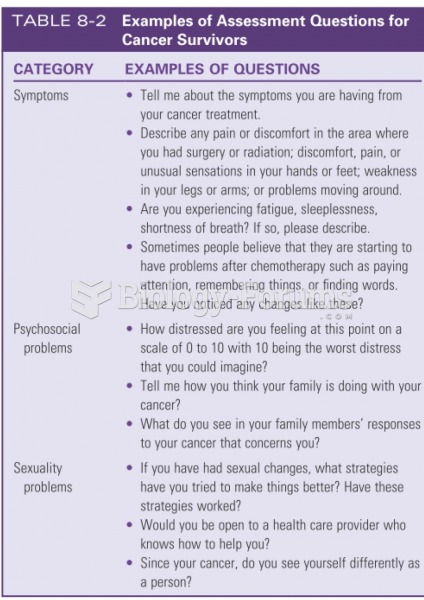Answer to Question 1
Correct Answer: 3,4
Rationale 1: Leukemia cells have a high growth fraction and are more sensitive to chemotherapeutic agents than are cells with a low growth fraction.
Rationale 2: Lymphoma cells have a high growth fraction and are more sensitive to chemotherapeutic agents than are cells with a low growth fraction.
Rationale 3: Breast cancer cells have a low growth fraction and are less sensitive to cell cycle specific chemotherapeutic agents.
Rationale 4: Lung cancer cells have a low growth fraction and are less sensitive to cell cycle specific chemotherapeutic agents.
Rationale 5: Bone marrow cells have a high growth fraction and are more sensitive to chemotherapeutic agents than are cells with a low growth fraction.
Global Rationale: Cell cycle specific drugs are most effective in treating hematologic malignancies and other cancers that have a relatively large proportion of cells proliferating at any given point in time. Examples are leukemia, lymphoma, and bone marrow cancers. Lung cancer and breast cancer have low growth fractions and are less sensitive to cell cycle specific chemotherapeutic agents.
Answer to Question 2
Correct Answer: 4
Rationale 1: Lung cancer cells do not have a very erratic cell cycle.
Rationale 2: Lung cancer cells might grow for a long time before detection, but this is not the primary reason they are less susceptible to antineoplastic agents.
Rationale 3: A high-oxygen environment is not the reason that lung cancer cells are less sensitive to antineoplastic agents.
Rationale 4: The growth fraction is the ratio of the number of replicating cells to the number of resting cells. Antineoplastic drugs are much more toxic to tissues and tumors with high growth fractions. Breast and lung cancers have a low growth fraction.
Global Rationale: Solid tumors such as breast and lung cancer generally have a low growth fraction; therefore, they are less sensitive to antineoplastic agents. Lung cancer cells do not have a very erratic cell cycle. Lung cancer cells might grow for a long time before detection, but this is not the primary reason they are less susceptible to antineoplastic agents. A high-oxygen environment is not the reason that lung cancer cells are less sensitive to antineoplastic agents.







